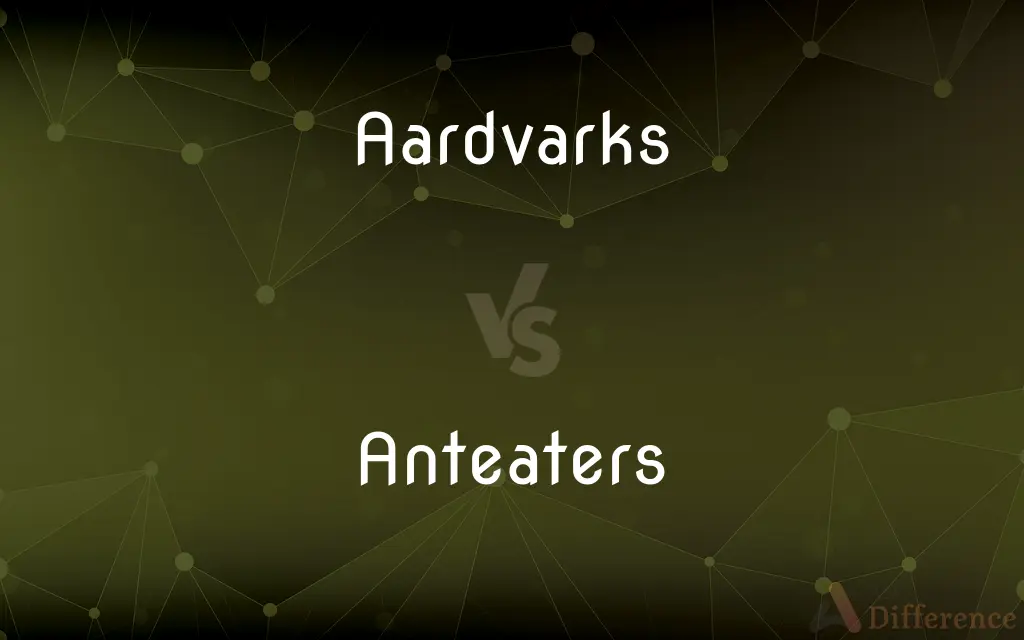Aardvarks vs. Anteaters — What's the Difference?
By Tayyaba Rehman — Published on December 23, 2023
Aardvarks are nocturnal mammals from Africa, while Anteaters are from Central and South America; both eat ants and termites.

Difference Between Aardvarks and Anteaters
Table of Contents
ADVERTISEMENT
Key Differences
Aardvarks are unique mammals native to Africa. These creatures have a distinct appearance, including a long snout and strong digging legs. Anteaters, on the other hand, are found in Central and South America and can be identified by their elongated snouts and large, bushy tails.
Aardvarks have a pig-like snout and large ears resembling those of a rabbit. Their sturdy legs are equipped for digging, helping them access ants and termites in the ground. Anteaters have a more slender body shape, with a snout that's tubular and long, perfectly designed for reaching into anthills.
When it comes to habitat, Aardvarks prefer the grasslands, woodlands, and savannahs of Africa. They are primarily nocturnal creatures, coming out at night to feast on their preferred diet. Anteaters, however, inhabit a range of environments, from grasslands to rainforests, and can be active during the day or night depending on the species.
Dietary habits of both Aardvarks and Anteaters include ants and termites, but they have different methods of consumption. Aardvarks use their strong claws to dig up termite mounds, then lick up their prey with a sticky tongue. Anteaters, conversely, use their long tongues to extract ants and termites from their nests without destroying the entire mound.
While both Aardvarks and Anteaters share a love for ants and termites, they belong to different animal families. Aardvarks are the only members of the family Orycteropodidae, while Anteaters belong to the family Myrmecophagidae.
ADVERTISEMENT
Comparison Chart
Native Region
Africa
Central and South America
Physical Appearance
Pig-like snout, large ears
Elongated snout, bushy tail
Active Time
Mostly nocturnal
Varies by species (day or night)
Eating Method
Dig up termite mounds
Extract without destroying the mound
Family
Orycteropodidae
Myrmecophagidae
Compare with Definitions
Aardvarks
Aardvarks have sturdy legs ideal for digging.
The Aardvarks quickly burrowed into the ground when threatened.
Anteaters
Anteaters have a bushy tail and slender body.
The silhouette of the Anteaters against the sunset was breathtaking.
Aardvarks
Aardvarks use their sticky tongues to consume ants and termites.
Aardvarks can eat thousands of insects in one night.
Anteaters
Anteaters are indigenous to Central and South America.
During our trip to Brazil, we observed Anteaters in the wild.
Aardvarks
Aardvarks are nocturnal mammals from Africa.
I saw Aardvarks during my night safari in Kenya.
Anteaters
Anteaters use their long tongues to eat ants and termites.
Anteaters can consume thousands of ants in mere minutes.
Aardvarks
Aardvarks have a distinctive pig-like snout.
The child was fascinated by the Aardvarks' unique facial features.
Anteaters
Anteaters belong to the Myrmecophagidae family.
Anteaters are the primary members of the Myrmecophagidae family.
Aardvarks
Aardvarks belong to the Orycteropodidae family.
In biology class, we learned that Aardvarks are the sole members of their family.
Anteaters
Anteaters possess a long, tubular snout.
The Anteaters' snout is specially adapted for extracting ants.
Aardvarks
A burrowing mammal (Orycteropus afer) of sub-Saharan Africa, having a stocky body, large ears, a long tubular snout, and powerful digging claws for feeding on ants and termites.
Anteaters
Any of several Central and South American mammals of the suborder Vermilingua that lack teeth and feed on ants and termites, especially the giant anteater.
Aardvarks
Plural of aardvark
Anteaters
Any of several other animals, including the echidna, aardvark, and pangolin, that feed on ants.
Anteaters
Plural of anteater
Common Curiosities
Which animal has a pig-like snout, Aardvarks or Anteaters?
Aardvarks have a pig-like snout.
Where are Aardvarks naturally found?
Aardvarks are native to Africa.
What do both Aardvarks and Anteaters primarily eat?
Both Aardvarks and Anteaters eat ants and termites.
Which animal belongs to the Orycteropodidae family?
Aardvarks belong to the Orycteropodidae family.
Are Anteaters related to Aardvarks?
No, Anteaters and Aardvarks are different species and belong to different families.
How do Anteaters consume ants without destroying the entire mound?
Anteaters use their long tongues to extract ants and termites without fully destroying the mound.
Do both animals have sticky tongues?
Yes, both Aardvarks and Anteaters have sticky tongues to help capture ants and termites.
How many species of Anteaters exist?
There are four main species of Anteaters.
Are Anteaters nocturnal like Aardvarks?
It varies; some Anteaters are diurnal while others are nocturnal.
Can Aardvarks climb trees like some Anteaters can?
No, Aardvarks are primarily ground-dwelling creatures.
Are Aardvarks endangered?
Aardvarks are not currently classified as endangered, but their populations are affected by habitat destruction.
How long is the tongue of an Anteater?
An Anteater's tongue can be up to 2 feet long.
Can Aardvarks swim?
Aardvarks are capable of swimming but are not commonly found in water.
Do Aardvarks and Anteaters have teeth?
Aardvarks have teeth, albeit back molars, while Anteaters lack teeth altogether.
Which is larger, an Aardvark or an Anteater?
It depends on the species of Anteater, but the Giant Anteater can be larger than an Aardvark.
Share Your Discovery

Previous Comparison
Descriptive Research vs. Experimental Research
Next Comparison
Premier League vs. Champions LeagueAuthor Spotlight
Written by
Tayyaba RehmanTayyaba Rehman is a distinguished writer, currently serving as a primary contributor to askdifference.com. As a researcher in semantics and etymology, Tayyaba's passion for the complexity of languages and their distinctions has found a perfect home on the platform. Tayyaba delves into the intricacies of language, distinguishing between commonly confused words and phrases, thereby providing clarity for readers worldwide.












































